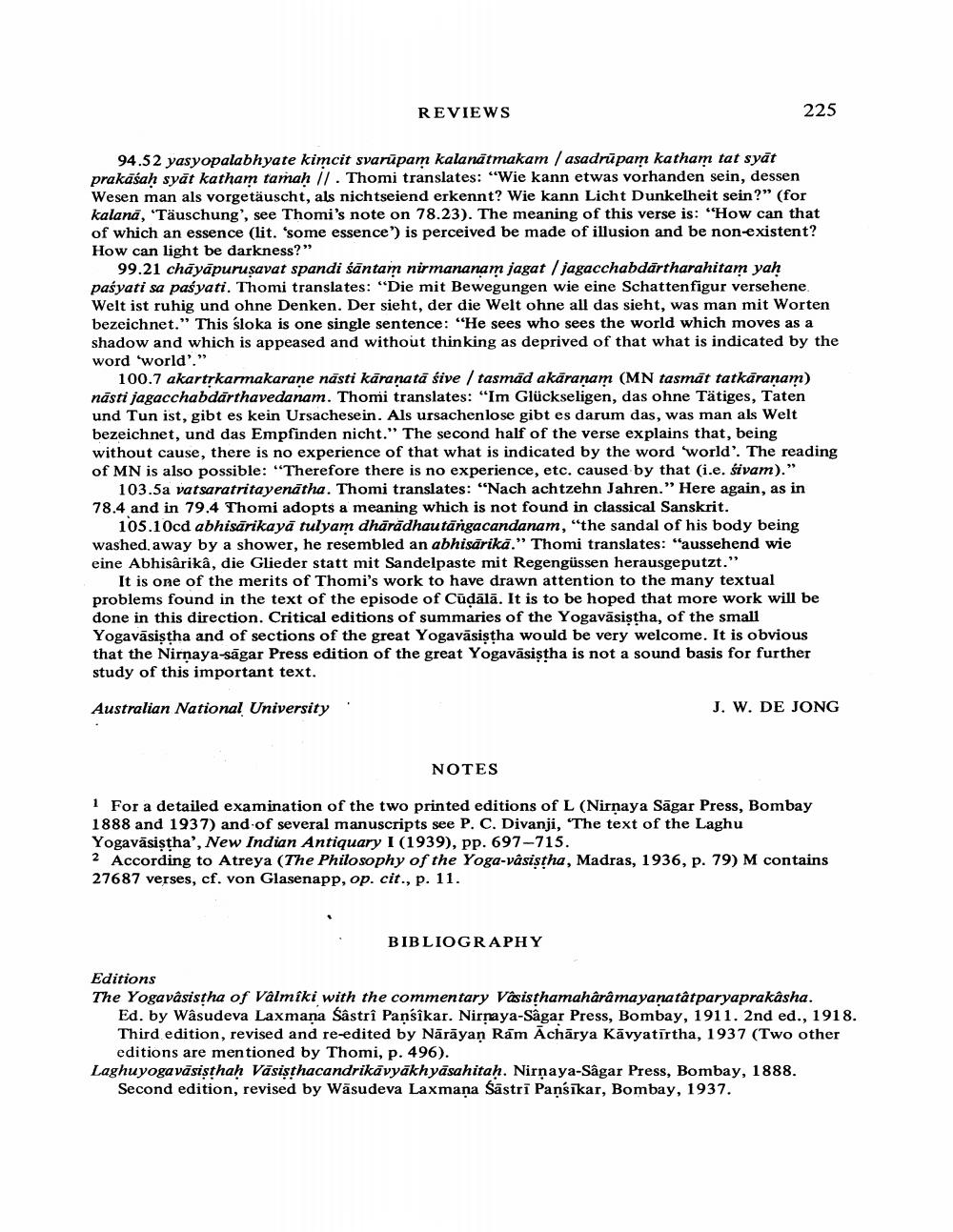Book Title: Book Reviews Author(s): J W De Jong Publisher: J W De Jong View full book textPage 7
________________ REVIEWS 94.52 yasyopalabhyate kimcit svarupam kalanātmakam / asadrūpam katham tat syāt prakāśaḥ syat katham tamaḥ //. Thomi translates: "Wie kann etwas vorhanden sein, dessen Wesen man als vorgetäuscht, als nichtseiend erkennt? Wie kann Licht Dunkelheit sein?" (for kalanā, "Täuschung', see Thomi's note on 78.23). The meaning of this verse is: "How can that of which an essence (lit. 'some essence') is perceived be made of illusion and be non-existent? How can light be darkness?" 99.21 chāyāpuruṣavat spandi śāntam nirmananam jagat / jagacchabdartharahitam yah pasyati sa pasyati. Thomi translates: "Die mit Bewegungen wie eine Schattenfigur versehene Welt ist ruhig und ohne Denken. Der sieht, der die Welt ohne all das sieht, was man mit Worten bezeichnet." This sloka is one single sentence: "He sees who sees the world which moves as a shadow and which is appeased and without thinking as deprived of that what is indicated by the word 'world'." 225 100.7 akartṛkarmakarane nästi kāraṇatā sive / tasmād akāraṇam (MN tasmāt tatkāraṇam) nāsti jagacchabdarthavedanam. Thomi translates: "Im Glückseligen, das ohne Tätiges, Taten und Tun ist, gibt es kein Ursachesein. Als ursachenlose gibt es darum das, was man als Welt bezeichnet, und das Empfinden nicht." The second half of the verse explains that, being without cause, there is no experience of that what is indicated by the word 'world'. The reading of MN is also possible: "Therefore there is no experience, etc. caused by that (i.e. sivam)." 103.5a vatsaratritayenatha. Thomi translates: "Nach achtzehn Jahren." Here again, as in 78.4 and in 79.4 Thomi adopts a meaning which is not found in classical Sanskrit. 105.10cd abhisarikaya tulyam dharadhautangacandanam, "the sandal of his body being washed away by a shower, he resembled an abhisārikā." Thomi translates: "aussehend wie eine Abhisârikâ, die Glieder statt mit Sandelpaste mit Regengüssen herausgeputzt." It is one of the merits of Thomi's work to have drawn attention to the many textual problems found in the text of the episode of Cuḍālā. It is to be hoped that more work will be done in this direction. Critical editions of summaries of the Yogavasiṣṭha, of the small Yogavāsiṣṭha and of sections of the great Yogavāsiṣṭha would be very welcome. It is obvious that the Nirnaya-sagar Press edition of the great Yogavāsiṣṭha is not a sound basis for further study of this important text. Australian National University NOTES BIBLIOGRAPHY J. W. DE JONG 1 For a detailed examination of the two printed editions of L (Nirnaya Sagar Press, Bombay 1888 and 1937) and of several manuscripts see P. C. Divanji, 'The text of the Laghu Yogavāsiṣṭha', New Indian Antiquary I (1939), pp. 697-715. 2 According to Atreya (The Philosophy of the Yoga-vâsistha, Madras, 1936, p. 79) M contains 27687 verses, cf. von Glasenapp, op. cit., p. 11. Editions The Yogavasistha of Valmiki with the commentary Vasisthamahârâmayaṇatâtparyaprakasha. Ed. by Wâsudeva Laxmana Śâstrî Pansîkar. Nirnaya-Sagar Press, Bombay, 1911. 2nd ed., 1918. Third edition, revised and re-edited by Nārāyaṇ Rām Āchārya Kāvyatīrtha, 1937 (Two other editions are mentioned by Thomi, p. 496). Laghuyogavasisthaḥ Vasisthacandrikavyākhyasahitaḥ. Nirṇaya-Sâgar Press, Bombay, 1888. Second edition, revised by Wasudeva Laxmana Sastri Pansikar, Bombay, 1937.Page Navigation
1 ... 5 6 7 8 9 10 11 12 13 14 15 16 17 18 19 20 21 22 23 24 25 26
